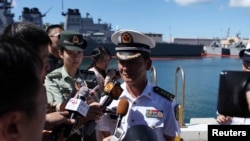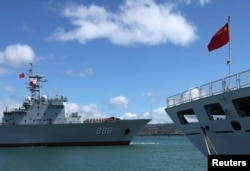As maritime tensions simmer between Beijing and its neighbors in the East and South China Seas, China for the first time is joining them in naval drills led by the United States. The military maneuvers also provide an exercise in diplomacy and intelligence gathering, analysts say.
The Rim of the Pacific (RIMPAC) naval exercises, conducted every two years in Hawaii, are meant to strengthen international relationships and ensure maritime safety and security. This year, 22 nations are participating in the drills, which began last weekend and continue through Aug. 1. Thailand’s invitation was retracted following the military coup there in May.
Dean Cheng, senior research fellow for Chinese political and security affairs at the Heritage Foundation, a conservative think tank in Washington, said it's important to understand that RIMPAC is an exercise in warfare techniques.
"You would be seeing the participants, most of whom are U.S. allies, engaging in a variety of activities that you would see in actual wartime," he said. "These are not the sorts of things you necessarily want to show countries that you think may become adversaries."
Strained relations
China is at odds with several of the RIMPAC participants.
Japan has clashed with it over disputed territory in the East China Sea. And the Chinese have been angered by Japanese officials’ visits to the Yasukuni Shrine in Tokyo, which honors Japan’s war dead – including convicted war criminals.
The Philippines has its own territorial dispute with China.
The United States invited China to take part in the naval exercises to encourage a stable, “sustained and substantive” military relationship with Beijing, a State Department official, Dan Russel, said in recent congressional testimony on the future of the two countries’ relations.
The Chinese may have another motive, said Sulmaan Khan, assistant professor of Chinese foreign relations at Tufts University’s Fletcher School of Law and Diplomacy.
“For China at least, it’s not clear that this is going to build as much trust as it would on the American side,” Khan said. “Whereas [Washington] D.C. might be hoping that this will build trust, show our intentions to build a good relationship, for the Chinese participants there’s going to be the question of ‘yes, but what are the Americans leaving out? What are we not seeing in these exercises?’ It’s as much a fact-finding mission for them as much as anything else.”
Source for ‘intelligence gathering’
Cheng characterized China’s participation in this year’s RIMPAC as "intelligence gathering."
"One of the things we didn’t do during the Cold War was to invite the Soviets, for example, to participate in the [NATO] Reforger exercises or the Ocean Safari exercises," he said.
Reforger exercises – short for "return of forces to Germany" – were conducted annually from 1969 to 1993 “to test U.S. ability to move conventional military forces rapidly from the continental United States to Central Europe,” according to the Global Security website.
NATO ran Ocean Safari maritime exercises in the North Atlantic during the 1970s and 1980s.
RIMPAC participants engage in drills that are unique outside of combat, according to Cheng.
"Among the other things that you do at this particular exercise is you actually fire live weapons at targets," he said. "This is the sort of thing that a submarine commander might do once or twice in his entire career, barring war time, of course."
The exercises also give countries an opportunity for improving relations and burnishing their image.
One of China’s goals in participating in RIMPAC may be to enhance its stature in the eyes of its own people, Khan said.
"Chinese leaders have been discussing a new model of great power relations," he said, "and being invited to a U.S.-convened set of naval exercises would seem to fit that bill.”














